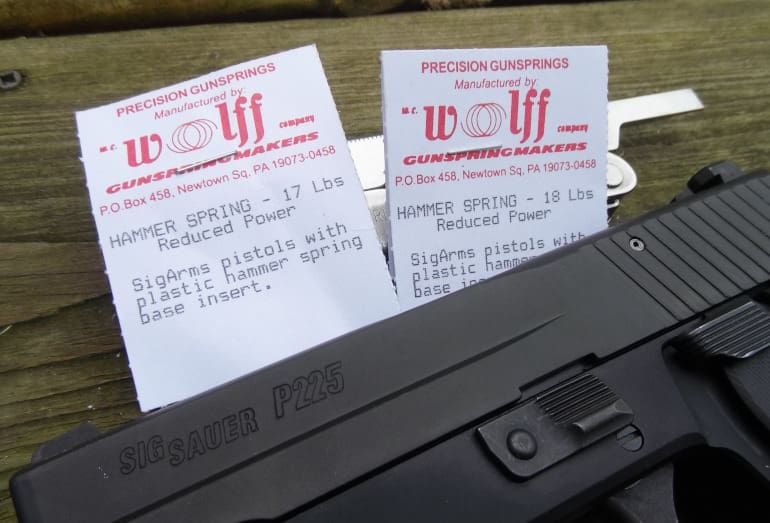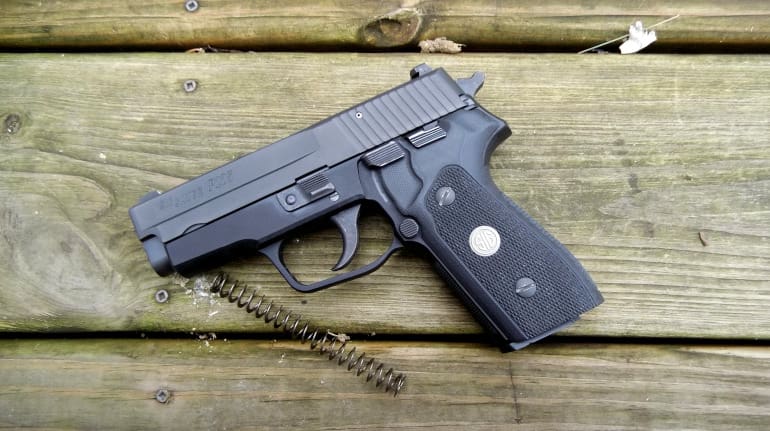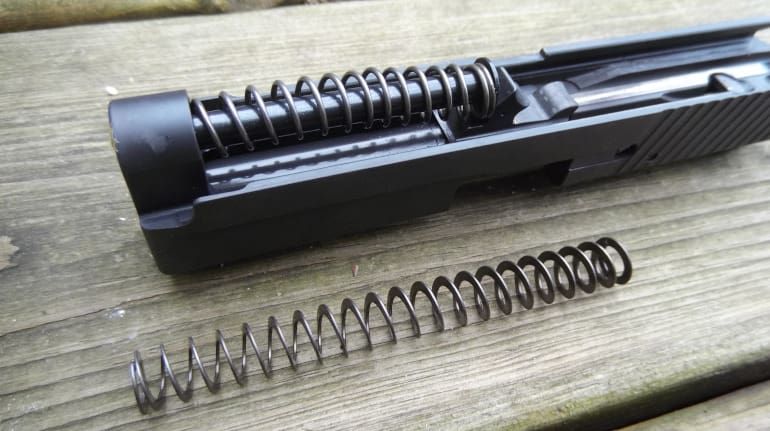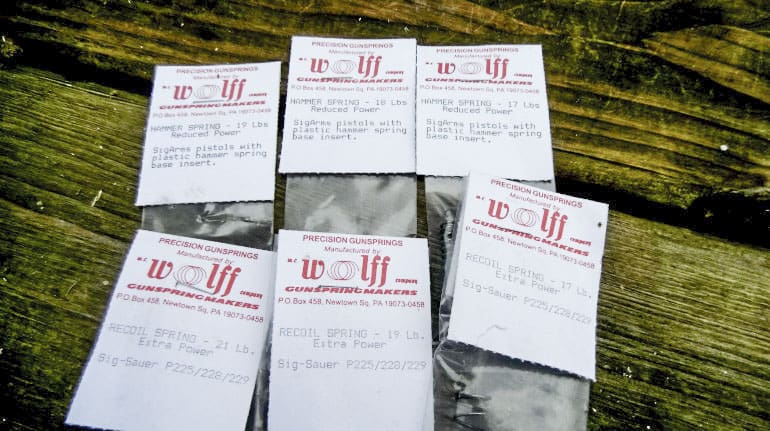
When it comes to buying used guns, there is nothing more frustrating than dealing with some of the creative choices of the previous owner(s). When I picked up a used SIG SAUER P225 A1 the other day, I was expecting a walk in the park, just like I do when I unbox a brand new SIG pistol for review. But that was not to be.
Today we’re going to look at tuning a pistol with new Wolff springs and what you can expect to achieve as a result.
I have been buying guns and fixing them up for years, from Mausers to J-Frames, and I’m always surprised when I see the lengths to which some people go to “improve” their firearms. There are many things I consider borderline criminal when it comes to the cosmetic features of guns, such as cheap and gawdy accessories and vomitous paint schemes, but nothing compares to the unforgivable sacrilege of…sporterization.
Some people are more subtle in their chosen improvements, such as filing and tweaking the internals to run better with a given type of ammo or polishing surfaces to reduce friction. It can take a trained eye to spot these things, but even a seasoned dumpster diver like me can be misled on occasion.
I recently picked up a SIG SAUER P225 A1 pistol in good condition. This is a very nice gun that’s an update to one of the original SIG carry guns. The A1 designation brings modern features to the old gun and makes it arguably one of the most comfortable guns made. If you haven’t wrapped your mitts around one, I very much recommend you do.

The gun is a relatively simple compact single-stack version of the full size 9mm P229. This is not really a review of this pistol, but its design is important here. The P225 A1 is compact, about the same overall size as a GLOCK 19, but isn’t chunky or bulky. It’s a double/single action with a de-cocker, the same as most SIG pistols.
The only serious complaint about the gun is its capacity. They only hold eight rounds with one in the chamber. The magazine body is basically the same as that used in the P239, which is a smaller gun. I would love it if SIG came out with a dedicated nine round or slightly extended ten round mag for this otherwise excellent pistol. It wouldn’t take much effort to do and would remove any perceived handicap of carrying a midsize 9mm with comparatively low capacity. SIG managed to fit 10 rounds into the minuscule P365 so it seems possible in the P225.
When I took this gun to the range after I picked it up, I was deeply saddened. The thing wouldn’t cycle at all. I thought it was because I was using cheap target ammo, but the problem persisted with every single load I tried. I experienced just about every failure known to man that frustrating afternoon.
Many people would simply give up on the gun and sell it at that point, but I decided to see if I could make it cycle.

My first task was to clean it and go back to the range. I wiped about a tablespoon of gunk out of it and removed some mysterious burrs on the slide rails with a fine stone. Confident in my results, I fired it again with everything from 115gr plated rounds to some Buffalo Bore +P+.
The gun cycled a bit better, if you consider a malfunction every other shot better. At that point I knew something was wrong inside the gun. The trigger was admittedly heavy, but I was right in the middle of doing a bunch of .44 Magnum articles with double action revolvers and thought nothing of it.
I was troubleshooting the gun in my workroom and noticed that there appeared to be a great deal of upwards pressure being applied to the slide by the hammer as the slide moved to the rear. That’s when I decided to take a new route and get her some new springs.
My first mistake was assuming that the gun was all original when I bought it. SIG wouldn’t send out a gun that wouldn’t cycle with their own brand of ammo at the very least. I made note that the hammer spring was unusually heavy at this stage and the recoil spring weight was curiously light.
I did some reading and discovered that many people erroneously install a new hammer spring to increase the power of hammer strikes. It’s likely that the previous owner bought a case of ammo with hard primers and thought a new spring was the key to getting reliable ignition. Many people don’t consider that or don’t want to deal with getting rid of their ammo and will alter the gun instead. Weird, but it happens.
My next clue was the recoil spring. It was very light…so much so that it didn’t have sufficient forward momentum to strip a fresh round off the magazine. While easy to rack, the weak spring caused the slide to lose momentum during its rearward travel due to the increased power of the hammer spring. In a sense, the hammer was dragging and slowing the slide down enough to cause the gun to malfunction.
I called Wolff Gunsprings, the premier maker of all things spring-related, and discussed it with them. After I finished the conversation, I received two packs of springs to tune the gun. Each pack consisted of three different springs of different poundage ratings. I now had three firing pin springs, three recoil springs (21#, 19#, 17#), and three hammer springs (19#, 18#, 17#).

I took the gun, the springs, and a variety of ammo types to the range and set about testing them. I fired the clean gun with the springs it came with and instantly had malfunctions with each ammo type. Then I removed the hammer spring and replaced it with the lightest one at 17 pounds. What a difference it made. While I had an issue with light strikes, the trigger pull was dramatically reduced. The slide was now able to come back at full velocity with nothing to slow it down.
But a light recoil spring coupled with a light hammer spring wasn’t a great combination. The slide moved so quickly under recoil that it was slamming into the frame and again caused malfunctions. Not good.
I slipped the 21-pound version on the guide rod and the 17-pound hammer spring with the 18-pound one. It worked as far as eliminating the light strikes, but it slowed the slide down too much to where most ammo wouldn’t allow it to lock back empty or even cycle all the way. My recoil spring was now too strong.
Next, I replaced the 21-pound recoil spring with the 19-pound version. This worked for the most part, but the gun still didn’t feel right. The firing pin marks were still too light for comfort and the slide was still a bit too stiff. The recoil felt jarring, not smooth, although it was now cycling 100% with all ammo.
My last combination was to install the 17-pound recoil spring and the 19-pound hammer spring…and it was as if the lights all suddenly turned green. The slide velocity was smooth and it locked back on an empty mag with all types of ammo. The primer marks were deep and the trigger pull in both double and single action was far, far lighter and smoother than what I started with. The gun was like a whole new animal and it just wanted to shoot anything I put in it.
So this story had a happy ending, but that’s not always the case with many unfortunate guns out there. If you’re having difficulties with your pistol, I’d suggest you start by changing out the springs. There’s no guarantee that your gun will be more accurate and reliable, but it’s worth a shot before you sell or consider major alterations.
In my talk with Wolff, they told me that many people are under the impression that certain spring kits will enhance accuracy, slide unlock timing, and a variety of other things. While this can be true, it all depends on the individual gun.
My results here may not be your results, even with the same model of pistol. The previous owner clearly thought that changing the springs would enhance the gun, but that was obviously not the case. I would absolutely recommend trying out several springs like I did here to get the best results.




Where did all the comments go?
This is meant for the Possum :
We know what ya meant, Marsupial One… 🙂
Based on the browser cache I had when I opened this article, all the comments were from December 19th, 2018.
If articles are going to be recycled, at least list at the top when they were originally posted or state if the story has been updated…
My Makarov started to malfunction with ammo that it had liked previously. I first thought it was a bad mag. Recoil spring was at fault. In a straight blow back the recoil spring has to be just right.
I contacted Wolff and got a factory standard mag. It worked a charm. I recently gave that gun to another person and gave them a heads up about the spring and who to contact if they ever need another.
I swapped a recoil spring in a beretta A391 because I shot trap with light loads and it was a recommended swap by Cole Guns. The gun wouldn’t always load the second shell for doubles. But if I wanted to use anything else I had to swap it back so as to not damage the gun. That’s a good reason to changed a spring.
Unless there is a good reason to do so changing the springs in a semi, or any gun, is probably a bad idea. Engineers work out the best combination and the only reason to replace is if they fail or are noticeably weak. In my example I was loading light and close to the cyclic limit of the gun.
Well, in light of all the disappearing comments that have been zapped this past week, I’ll give this one a go and see it if sticks.
Be careful when replacing springs in any stiffness rating other than the factory OEM settings. Especially for the main recoil spring. It’s tempting to go one step lighter to help with cycling, but then you start messing with proper timing of the spent case being ejected as the powder burn is occurring, which can permit fouling of the interior of the gun, which can affect proper movement of the trigger mechanism and safety plunger (if applicable), which can make your 5-lb trigger turn into a 10-lb trigger, etc. etc.
I installed a lighter spring on my wife’s G19 to help her with the stove-piping she kept experiencing due to muzzle flip. Helped her keep her hand steady and hit the target more consistently, but started fouling the interior of the gun and required constant cleaning. Finally put the factory spring back in and told her to work on her wrist strength instead. And guess what…after some difficulty, she eventually did, and now effectively shoots Glocks with no problem.
I have to disagree here. In the case of military handguns, many countries have a very heavy trigger spring(P-64 comes to mind), they think the heavy spring makes it safer carrying a cocked handgun. These can be very hard to shoot, the difference in SA and DA make it like a different gun.
Many of these firearms were designed to fire a hotter round(European 9mm short vs our .380ACP). We should tune these guns to fire the ammo we are using. Another thing to think about is the age of the gun. After 50 years, the old steel used in the springs has lost something. New springs and a good cleaning can make the gun feel almost like your new Sig after 500 rds.
I understand what you’re saying, but note that I said to be aware of the “original stiffness” of the factory springs. I didn’t recommend that they not be changed at all. I’ve replaced older springs on vintage guns and seen them return to spectacular performance, but those were always with Wolff springs at original factory stiffness. What I said above is that one needs to be careful when replacing springs with different stiffnesses, as the gun will behave differently and other aspects of its operations may be unexpectedly affected.
But certain mods are beneficial when performed by someone who knows what he/she is doing, so TEHO.
Perhaps a decent place to start, for many of us, would be to simply replace the springs with an OEM set in OEM weight. If that works, great, and you can then proceed to tune further knowing you found the root cause of the issue; if not, you know to look elsewhere for the problem.
Exactly. Why you would buy non-OEM springs right off the start makes no sense.
I can see starting with aftermarket springs if you know what you’re doing, and you know you will want to make some adjustments to trigger pull etc. after you get it working again.
I’m not that advanced yet, myself.
I guess if, for whatever reason, OEM springs aren’t available, or are far more expensive, that would be another reason to consider it.
You buy a used gun & don’t take it apart or reclean & inspect it before you shoot it. That’s what I’d call the idiot gunner.
I do it to brand new guns before I shoot them!
I have to agree with you on that point, and it’s really Gun Safety 101 issue. Nothing gets loaded or fired until it’s been field stripped, cleaned and lubed right. Whether it’s brand spanking new or used. With a used gun, I’d say it’s even more important, because I’ve seen some real crap cleaning jobs. One gun I bought, I could swear the previous owner used axle grease.
“the premier maker of all things spring-related”
Is this supposed to be a story or an advertisement? I think more advertisement.
well, they are, pretty much
yep. most all malfunctions are because the gun needs cleaning, new factory springs, or magazine problems.
…Especially 1911’s. I bought 2 used Les Baer’s at 2 different times and the first thing I did with each was to strip and clean (the guns) and replace all springs. They shoot like new ( I have new Baer’s too) and are good to go for another 5000 rounds before replacing springs again. I used to shoot USPSA/IPSC in open class. New springs every season were a necessity otherwise I started getting light primer strikes and jams.
+ 1000 on that. My Baer started refusing to refuse to extract spent casings, turning my several thousand dollar race gun into a single shot .38 super.
Admittedly, I struggled with it. After fiddling with the extractor, ejector, mags, and powder some old timers threw a new spring in there and it rattled off a full 36 rounder and never missed a beat. Live and learn!
You can Tune a Piano, but you can’t Tuna Fish.
Really doubt that 225A1 ate 5000 rounds already. usually the old sigs with the Pinned breech block has a service rotation about 5000 rounds till replacing the pins and springs. The newer ones and the improved springs they use I don’t know the recommended round count to change everything. no one ever talks about changing pistol mag springs much.
REO Speedwagon “you can tune a piano but you can’t tune a fish.” good album.
Confirm: same ordeal with a Sig P6, ex-Bundesgrenzschutz
Wolff made it all work like new.
I just put brand new +10% wolff springs in my EDC carry magazines. Aside from one minor mishap (Thank you safety glasses) they went in just fine.
For a Sig I always use the factory twisted coil springs. They always seem to work better. My P6 has a Sig P225 factory recoil spring and the 19 lb hammer spring. Sig does not say what the weight of the recoil spring is on their parts kit.
How about buy a new gun and don’t fuck with it. The designers know what they are doing.
@ Joseph, not everybody wants or can buy a new gun. Wolf springs are one of the premier aftermarket suppliers of replacement springs. If you don’t want to buy or replace springs on a gun don”t buy any. Nobody is gonna yell at you.
Comments are closed.